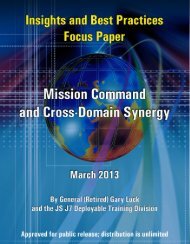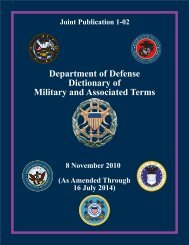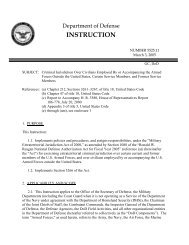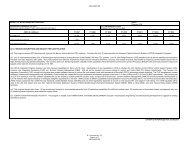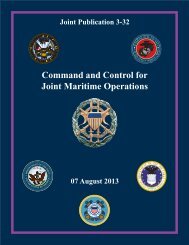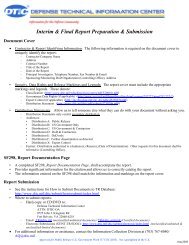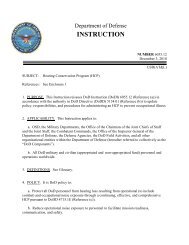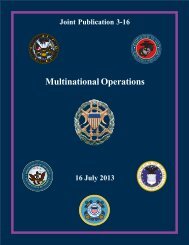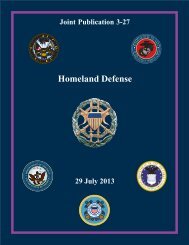JP 1, Doctrine for the Armed Forces of the United States - Defense ...
JP 1, Doctrine for the Armed Forces of the United States - Defense ...
JP 1, Doctrine for the Armed Forces of the United States - Defense ...
Create successful ePaper yourself
Turn your PDF publications into a flip-book with our unique Google optimized e-Paper software.
CHAPTER IV<br />
JOINT COMMAND ORGANIZATIONS<br />
“…success rests in <strong>the</strong> vision, <strong>the</strong> leadership, <strong>the</strong> skill and <strong>the</strong> judgment <strong>of</strong> <strong>the</strong><br />
pr<strong>of</strong>essionals making up command and staff groups…”<br />
1. General<br />
SECTION A. ESTABLISHING UNIFIED AND<br />
SUBORDINATE JOINT COMMANDS<br />
Dwight D. Eisenhower<br />
Crusade in Europe, 1948<br />
Joint <strong>for</strong>ces are established at three levels: unified CCMDs, subordinate unified<br />
commands, and JTFs.<br />
a. Authority to Establish. In accordance with <strong>the</strong> National Security Act <strong>of</strong> 1947 and<br />
Title 10, USC, and as described in <strong>the</strong> UCP, CCMDs are established by <strong>the</strong> President,<br />
through SecDef, with <strong>the</strong> advice and assistance <strong>of</strong> <strong>the</strong> CJCS. Commanders <strong>of</strong> unified<br />
CCMDs may establish subordinate unified commands when so authorized by SecDef<br />
through <strong>the</strong> CJCS. JTFs can be established by SecDef, a CCDR, subordinate unified<br />
commander, or an existing JTF commander.<br />
b. Basis <strong>for</strong> Establishing Joint <strong>Forces</strong>. Joint <strong>for</strong>ces can be established on ei<strong>the</strong>r a<br />
geographic area or functional basis.<br />
(1) Geographic Area. Establishing a joint <strong>for</strong>ce on a geographic area basis is <strong>the</strong><br />
most common method to assign responsibility <strong>for</strong> continuing operations. The title <strong>of</strong> <strong>the</strong><br />
areas and <strong>the</strong>ir delineation are prescribed in <strong>the</strong> establishing directive. Note: Only GCCs are<br />
assigned AORs. GCCs normally assign subordinate commanders an operational area from<br />
within <strong>the</strong>ir assigned AOR.<br />
For fur<strong>the</strong>r in<strong>for</strong>mation on operational areas, refer to <strong>JP</strong> 3-0, Joint Operations.<br />
(a) The UCP contains descriptions <strong>of</strong> <strong>the</strong> geographic boundaries assigned to<br />
GCCs. These geographic AORs do not restrict accomplishment <strong>of</strong> assigned missions;<br />
CCDRs may operate <strong>for</strong>ces wherever required to accomplish <strong>the</strong>ir missions. The UCP<br />
provides that, unless o<strong>the</strong>rwise directed by SecDef, when significant operations overlap <strong>the</strong><br />
boundaries <strong>of</strong> two GCCs’ AORs, a JTF will be <strong>for</strong>med. Command <strong>of</strong> this JTF will be<br />
determined by SecDef and <strong>for</strong>ces transferred to <strong>the</strong> JTF commander through a CCDR,<br />
including delegation <strong>of</strong> appropriate command authority over those <strong>for</strong>ces.<br />
(b) Each GCC and subordinate JFC will be kept apprised <strong>of</strong> <strong>the</strong> presence,<br />
mission, movement, and duration <strong>of</strong> stay <strong>of</strong> transient <strong>for</strong>ces within <strong>the</strong> operational area. The<br />
subordinate JFC also will be apprised <strong>of</strong> <strong>the</strong> command channels under which <strong>the</strong>se transient<br />
<strong>for</strong>ces will function. The authority directing movement or permanent location <strong>of</strong> transient<br />
<strong>for</strong>ces is responsible <strong>for</strong> providing this in<strong>for</strong>mation.<br />
IV-1



